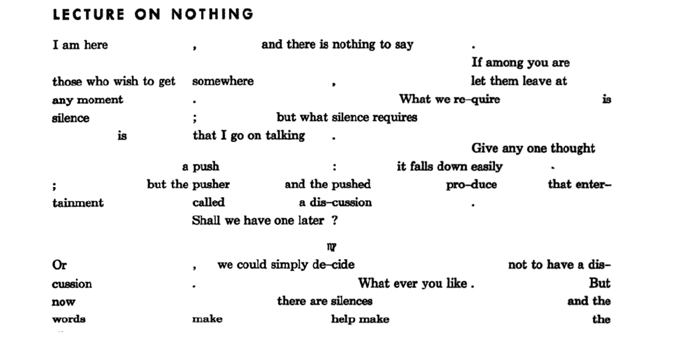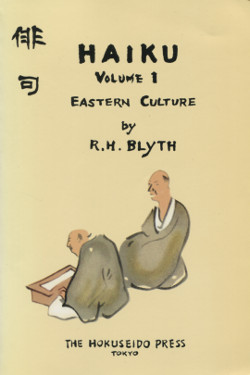
[This is part of the series Opening the door into emptiness]
With the String quartet in four parts, John Cage had found the sonic imagery that suited his new view of music as something “to sober and quiet the mind.” This new style was one of empty spans of time containing music that was not driven forward by a strong sense of personal expression. There was a gentleness, a static feeling, a quality of what Cage called “disinterestedness” in the music. There was a calm, open spaciousness inherent in the time structure, which was once empty of expression and full of possibilities.
Energized by the discoveries of the quartet, Cage created his first really great piece of writing in 1950, the “Lecture on nothing”. The lecture is one last presentation of his framework for music, the four elements of Structure, Form, Material, and Method. It contains the same concepts as “Defense of Satie” and “Forerunners of modern music” but delivered in a wholly original style. This was the first lecture that Cage wrote like a piece of music, structured using duration structure. Although he never said so, it seems quite possible his model was the string quartet. The pacing and flow are remarkably similar in both pieces, even down to the lengthy, “nearly stationary” parts in the middles of both.
“Lecture on nothing” eloquently presents Cage’s belief that self-negating discipline produces insight, those “rare moments of ecstasy, which, as sugar loaves train horses, train us to make what we make.” These disciplines, such as duration structures or the organized materials of the string quartet, are fundamentally empty: the composer’s personality and sense of self are not expressed within them. The emptiness of such systematic procedures is the “nothing” of the title. Such disciplines “say nothing”, and the composer “possesses nothing” in them. By getting the sense of self out of the way, the composer can experience music more clearly. “Structure without life is dead,” Cage says, “but life without structure is unseen. Pure life expresses itself within and through structure.”
Earlier, Cage would have used the more technical word “form” instead of “life” in a passage like this: this shows how his musical and spiritual searches were coming together. “Structure” led to “Mind” led to “self-denial” led to “nothing”. Cage had first let go of his ambition, the need to get somewhere in his professional life. Then he had let go of the need for his music itself to go anywhere. He was applying systematic procedures more widely in order to weaken the force of self-expression and let the eternal show through directly from this empty space. The direction his compositional path was taking him was new, but it was also in accordance with what he had read in Coomaraswamy about the divine source of art, something beyond the expression of a merely human artist. It was in accord with what he had read in Jung about opening to the mysterious unconscious side of the psyche, not just the rational conscious mind. It was in accord with what he had read in Meister Eckhart about ignorance and silence as the ground of all knowledge.

It was also in accordance with the spiritual foundations of Japanese haiku poetry, as presented by R. H. Blyth in his multi-volume work Haiku. The first volume, subtitled Eastern culture, appeared in 1949. Blyth emphasized the spiritual dimensions of haiku, identified with Zen Buddhism. Like Coomaraswamy, he saw art and religion as inseparable, declaring at the outset of his book that “haiku is not only poetry, … it is a way of life.” Throughout Haiku: Eastern culture, he points specifically to the discovery of the eternal in everyday experience by embracing silence and attending to the concrete:
Haiku thus make the greatest demand upon our internal poverty. Shakespeare pours out his universal soul, and we are abased before his omniscience and overflowing power. Haiku require of us that our soul should find its own infinity within the limits of some finite thing. It is in this sense that nothing is hidden from us. Haiku is the result of the wish, the effort, not to speak, not to write poetry, not to obscure further the truth and suchness of a thing with words, with thoughts, and feelings.
The path of haiku that Blyth expresses here fit perfectly into Cage’s thinking at the time: a turning away from personal ambition and grand self-expression, a turning inwards to find a connection to the universal. Blyth’s imagery emphasized silence—“the effort not to speak”—as the practice needed to find the eternal in the particular: “the truth and suchness of a thing.” This can be seen as connected to the new compositional techniques of Cage’s string quartet, where the systematic treatment of material allowed for a personal compositional silence and a resulting instantaneous luminosity of harmony.
Blyth’s writing on haiku had a strong impact on Cage’s writing and thinking, as evidenced in the “Lecture on nothing.” The emphasis on “saying nothing”, on “going nowhere”, and on poetry and music as empty of personal expression while remaining full of universal meaning—these are all at the core of both Cage’s lecture and Blyth’s view of the spirit of haiku. Blyth repeatedly describes the spirit inherent in small moments in nature, and Cage does the same in “Lecture on nothing”. From Blyth:
A haiku is not a poem, it is not literature; it is a hand beckoning, a door half-opened, a mirror wiped clean. It is a way of returning to nature, to our moon nature, our cherry blossom nature, our falling leaf nature, in short, to our Buddha nature. It is a way in which the cold winter rain, the swallows of evening, even the very day in its hotness, and the length of the night become truly alive, share in our humanity, speak their own silent and expressive language.
In “Lecture on nothing”, Cage equates the musical element of Form with poetry, and he finds this poetry in moments of vivid experience:
A piece of string or a sunset, possessing neither, each acts and the continuity happens. Nothing more than nothing can be said.
Pure life expresses itself within and through structure. Each moment is absolute, alive and significant. Blackbirds rise from a field making a sound delicious beyond compare.
The significance of “Lecture on nothing” lies not so much in its ideas but from their expression. In it we hear the first sounding of Cage’s mature voice. By 1950 his compositional discoveries were coming together with his spiritual readings to form a more clear aesthetic stance and a practical way forward. Blyth declared the expressiveness of things in themselves, a “poetry of things” that arises from emptiness. Cage now saw himself as creating music along the same lines. His path was to find a “poetry of sounds” that could arise from the silence of his musical time structures.
Read the next post in this series: 7 — Following the master
Sources & asides
The “Lecture on nothing” appears in Silence, pp. 109-126. There has always been some confusion about the date of this lecture. In Silence, Cage says that it was delivered in 1949 or 1950, and others have suggested dates as late as 1952. Internal evidence in the lecture points squarely to 1950. In the afternote to the lecture, Cage presents the pre-written answers to any questions asked after the lecture. The third of these references a performance by Marya Freund “last April in Palermo”, a concert that Cage attended during his 1949 European tour. In the lecture proper, Cage mentions his idea of creating an organization “Capitalists, Inc.” (“so no one would think we were Communists”). He mentions this same idea in a letter to Pierre Boulez in January 1950, and Sen. Joseph McCarthy’s hunt for Communists in the government dates from early 1950 as well. Cage mentions Richard Lippold’s sculpture “Full moon”, which was made in 1949–1950. Finally, he tells the story of having gone to an arts conference “in a Virginia girls’ finishing school” where he met “America’s youngest college president”, a woman who had since resigned. Rob Haskins has identified this as the visit Cage made to Sweet Briar College in March 1950, where the president was Martha B. Lucas. She was indeed one of the youngest college presidents in America when she took office in 1946, and she resigned in May of 1950 after being unable to undo the school’s segregationist charter. All this taken together strongly points to a date some time in the latter half of 1950.
R. H. Blyth, Haiku, Volume One: Eastern culture (Tokyo: The Hokuseido Press, 1949). The first extended quotation presented above appears on page 242 and is actually cited by Cage himself as part of a series of letters to the editor of Musical America magazine in December 1950. These were reprinted as “Satie controversy” in John Cage, Kostelanetz, ed., pp. 89-92. The reference to Blyth (incorrectly spelled as “Blythe”) appears on page 90.
